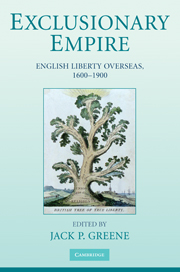Book contents
- Frontmatter
- Contents
- Notes on Contributors
- Preface
- Introduction
- 1 The Languages of Liberty in British North America, 1607–1776
- 2 Liberty and Slavery
- 3 “Era of Liberty”
- 4 Liberty and Modernity
- 5 Federalism, Democracy, and Liberty in the New American Nation
- 6 Liberty, Order, and Pluralism
- 7 Contested Despotism
- 8 “… a bastard offspring of tyranny under the guise of liberty”
- 9 How Much Did Institutions Matter?
- 10 The Expansion of British Liberties
- Index
2 - Liberty and Slavery
The Transfer of British Liberty to the West Indies, 1627–1865
Published online by Cambridge University Press: 05 June 2012
- Frontmatter
- Contents
- Notes on Contributors
- Preface
- Introduction
- 1 The Languages of Liberty in British North America, 1607–1776
- 2 Liberty and Slavery
- 3 “Era of Liberty”
- 4 Liberty and Modernity
- 5 Federalism, Democracy, and Liberty in the New American Nation
- 6 Liberty, Order, and Pluralism
- 7 Contested Despotism
- 8 “… a bastard offspring of tyranny under the guise of liberty”
- 9 How Much Did Institutions Matter?
- 10 The Expansion of British Liberties
- Index
Summary
English promoters and settlers were active participants in the settlement of the numerous islands adjacent to the continental Americas. During the two centuries after 1600, English men and women, operating under the auspices of chartered companies, proprietary groups, or the Crown, established thirteen separate island colonies: Bermuda, Barbados, the four Leeward Island colonies of Antigua, Montserrat, Nevis, and St. Kitts, and Jamaica during the first six decades of the seventeenth century; the Bahamas in the early eighteenth century; the Virgin Islands in the 1750s; and the four ceded islands of Dominica, Grenada, St. Vincent, and Tobago just after the Seven Years' War. Two of these island colonies, Bermuda and the Bahamas, were in the Atlantic, the rest in the West Indies. Later, as a result of the Napoleonic Wars, the British acquired St. Lucia from the French and Trinidad from the Spanish. Every polity answered directly to the metropole. If the Leeward Islands had a common governor, each of the four islands also had its own lieutenant governor and a local system of governance with exclusive jurisdiction over the island's internal affairs.
Unlike the Atlantic islands of Bermuda and the Bahamas, which were of marginal economic or strategic importance within Britain's larger American empire, the early West Indian settlements had, by the late seventeenth century, become the nation's most valuable American colonies.
- Type
- Chapter
- Information
- Exclusionary EmpireEnglish Liberty Overseas, 1600–1900, pp. 50 - 76Publisher: Cambridge University PressPrint publication year: 2009



